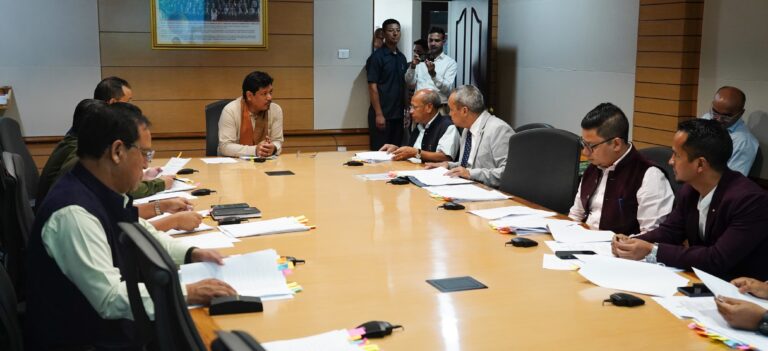SHILLONG, JULY 27: India and Bangladesh will soon sign a memorandum of understanding on elephant conservation and management and a joint operational guideline to handle trans-boundary migration of elephants.
Addressing at the 2nd Indo-Bangladesh Dialogue on Trans-Boundary Conservation of Elephants held here in the state capital, Bangladesh’s chief conservator of forests, Md Shafiul Alam Chowdhury said a protocol on elephant conservation and management between Bangladesh and India has been developed during the 2nd thematic meeting held on December 11-14, 2015 in Sundarbans, Bangladesh.
He said it was agreed to develop an operational guideline to handle trans-boundary migration of elephants including stray elephants.
“The follow up actions of this 2nd dialogue are now ongoing and a protocol or else a memorandum of understanding (MoU) and a joint operational guideline between the two countries are expected soon,” Chowdhury announced.
According to him, the aim of this dialogue was to ensure safe and free movement of trans-boundary wild elephants across the international borders between the two countries.
Chowdhury who led an 11-member delegation, informed that the Bangladesh forest department has been introducing a range of conflict management techniques at the grassroots level in which 146.3 lac taka has been provided as compensation for human death, human injury and crop damage since 2011.
Stating that conflicts between humans and wildlife must be considered a global raising issue, he said the intensity of human-elephant conflict (HEC) is fast growing in tropical and subtropical countries, which is now suddenly increased.
“The number of HEC incidents has increased since 2000. In Bangladesh, the scenario is also alarming, especially along the international border areas,” he said.
According to him, wild elephants of Bangladesh are divided into two groups – one local and another cross-border migratory which mainly come from India and Myanmar.
He said they use trans-border routes as a corridor for their movement adding that Indian elephants use the Meghalaya border as corridors for their movement.
Under the conflict management techniques, alternative cropping practices, bio-fencing, 20km solar powered fencing and setting up early warning systems on a pilot bases in different conflict prone areas have also been initiated, he added.
To enrich elephant habitats and secure the food sources for wild elephants, he said the Bangladesh forest department has undertaken a habitat improvement programme also where nearly 700,000 seedlings of elephant fodder species have been planted in over a 600 hectares area in Sherpur and Chittagong.
It may be mentioned here that regular migration of elephants between Bangladesh and India has been noticed from 30 corridors having South West Garo Hills and South Garo Hills Districts in Meghalaya on Indian side and Sherpur District on Bangladesh side. Of these, 12 corridors are used very frequently.
Trans-boundary migration of elephants through a corridor in Karimganj District of Assam has also been observed.
Speaking to reporters at the sidelines of the dialogue, Director General of Forests and Special Secretary to the Government of India Siddhanta Das said the elephant population in India has been growing.
“In fact two years back we had a population census of 30,000 elephants in which 9,000 are in Northeastern states,” he said.
The Elephant Range states in these regions include Assam, Meghalaya, Arunachal Pradesh, Nagaland, West Bengal and Tripura, which are home to more than 9,000 wild elephants, of which about 1,800 are found in Meghalaya alone.
Informing that a synchronize population study has been done in the last few months; Das said the result will come in a month or so and definitely indication are there that it is rising almost everywhere.
Asked, he said that dialogue seeks to discuss on various issues which include human-animal conflicts, maintaining of the corridors to give safe passage to the elephants and others for technical cooperation between the two countries.
He said that the Government of India will be helping the Meghalaya government to handle these issues from its elephant project.
On compensation for HEC, he said that the Government of India doesn’t provide much fund on that but however on the request or proposal from the state government it can consider.
With regards to steps being taken to prevent poaching of elephants, the director general of forests said that poaching is a state subject but the Centre under its elephant project will try to support the state government for preventing poaching.
During the last seven years in Meghalaya alone, 14,754 incidents of human elephant conflicts have been reported. These incidents includes 69 human deaths, 48 cases of human injuries, killing of 118 livestock, damage to 1325 houses and 113,194 cases of damage to crops.
Main reasons for degradation and fragmentation of elephant habitat include extension of human settlements and developmental projects to hitherto non-populated pristine core elephant bearing areas, deforestation and shifting cultivation.
The dialogue was inaugurated by the Meghalaya minister in-charge Urban Affairs Ronnie V Lyngdoh.

























+ There are no comments
Add yours